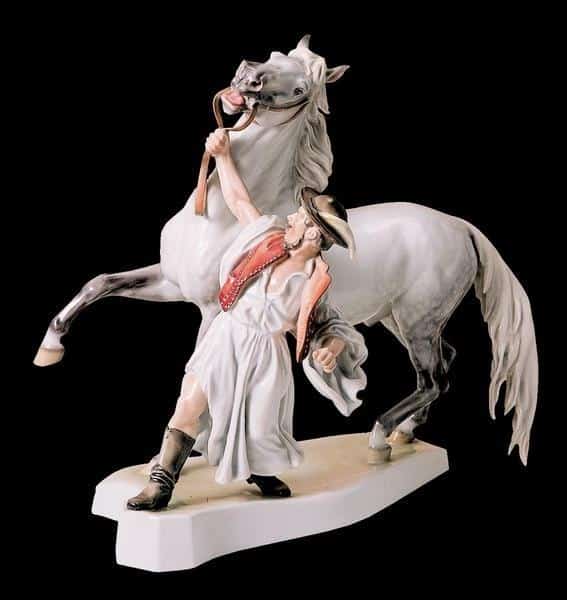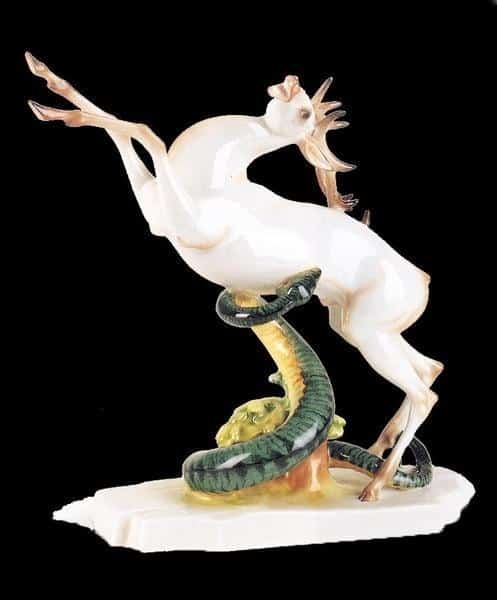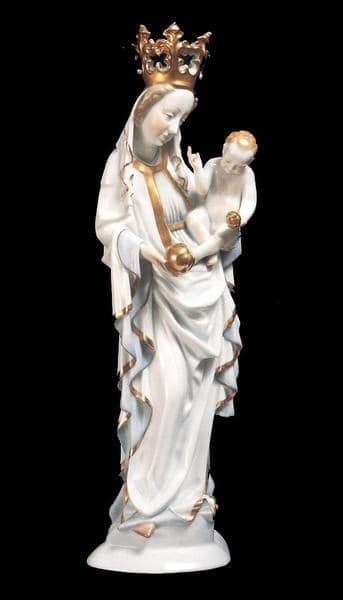Room VI.
STATUETTES
As the factory continued to win international honours (at Paris in 1900, St Petersburg in 1900/1901, St Louis in 1902, Milan in 1906 and Turin in 1911), people did not suspect that the development of the factory had halted. The troubles proliferated after the First World War. Herend only found its feet again in the 1930s. The change and the turn-round in the firm's fortunes were exemplified by the grand prix that Herend won at the Brussels world exposition of 1935.
Figurines and sculptures were not prominent in the Herend range in the 19th century, but many such pieces were made in the first half of the 20th century, in accordance with the tastes of the day. They joined the traditional Herend vessels and table services as prized adornments in wealthier homes. In the 1930s, the manufactory was in contact with almost all the applied arts. High-quality, tasteful figures appeared in large numbers.
The designs introduced between the 1920s and 1940s were the work of the following: Ilona Anka, Károly Csapváry, Pál Bánó, Ágoston Brand, Illés György Edvi, Géza G. Fekete, Kata Gácser, Lajos Gadi, Géza Gondos, János Horvay, Andor Hubay, Adolf Huszár, Imre Huszár, Sándor Kelety, Zsigmond Kisfaludi Strobl, Margit Kovács, László Krupinszky, Miklós Ligeti, Mária Lipthay, Antal Lonkay, István Lőrincz, Éva B. Lőte, Elek Lux, Béla Markup, Gyula Maugsch, Lívia Papini Kuzmik, János Pásztor, Zoltán Pohárnok, József Reményi, Piroska E. Richter, András Sinkó, István Szilágyi Nagy, Ede Telcs, Károly Ullrich, Éva Vastagh, György Vastagh Jr, Mrs György Vastagh Jr, and Pál Vincze.
In the years after nationalization, Herend was incorporated into the ceramics industry and subject to central economic planning. There were efforts to divert the manufactory towards large-scale production. Large numbers of small figures for political propaganda purposes (busts and plaques of Stalin and Lenin, for example) were made in the 1950s, of the kind found in every communist-party office.
However, Herend remained capable of exporting its products, which earned the country sizeable amounts of scarce foreign currency, so that the emphasis returned to more demanding pieces hand-painted in short runs. Earlier Herend forms and patterns were revived.
The artists of the 1950s, 1960s and 1970s were the following:
Éva Bakos, Sándor Boldogfai Farkas, Ágoston Brand, Tibor Bruck, Barna Buza, Jenő Hanzély, László Horváth, Imre Huszár, Irén Cs. Illés, Zsigmond Kisfaludi Strobl, Zoltán Olcsai Kiss, Pál Pázay, Mrs Mátyás Rákosi, Éva Szittya Horváth, Mrs István Torma, and János Tóth.
RANGEMAN

Horseherd by György Vastagh – figurine originated from the 1930s.
DEER-HUNTING

István Lőrincz – Herend’s most prolific design artist.
MADONNA OF TOPORC

Virgin of Toporc by Kata Gácser. The porcelain portrayal of a Gothic woodcarving. Humility and outstanding professionalism.

